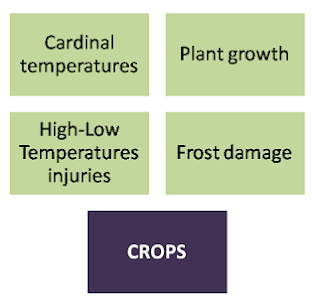Cardinal Temperatures Affects Growth Of Cultivar
For each phase in the growth of cultivar, there is a temperature range within which growth and development is optimum. These temperature ranges are called cardinal temperature.
The cardinal or threshold temperatures are:
- The minimum, below which there is insufficient heat for biological activity.
- The optimum, at which the rate of metabolic processes are at their maximum.
- The maximum, above which growth ceases.
How does air temperature affect crops and plant growth.
Many physical processes and chemical reactions, vital to crop growth are influenced by temperature. In general, active growth of commercial crops is confined to temperature of 5 degree to 40 degree centigrade. However, each crop, cultivar and the growth has its own temperature requirements beyond which their performance is limited.
Cardinal temperatures
Cool season cereals
- 0-15
- 25-30
- 31-37
Warm season cereals
- 15-18
- 31-37
- 44-50
Effect of temperature on pant growth.
Low or high temperatures than optimum required for optimum growth and development of crops leads to decreases in final yields.
Low temperature injuries
Low temperature affects several aspects of crop growth are:
survival, cell division, photosynthesis,water transport, growth and finally yield as indicated below:
Chilling injury
If the plants grown in hot temperature are exposed to low temperature, they will be killed or injured. When the night temperature is below 15 degree centigrade field crops may show yellowing symptoms.
Freezing injury
When the plants are exposed to low temperature , water freezes into ice crystals in the inter-cellular spaces as in the temperate crops (potato, tea etc.)
Suffocation
Formation of thick cover of ice/snow on the soil surface prevents the entry of oxygen and crop suffers. This effects respiration and lead to accumulation of harmful substances.
Heaving
It is lifting of plants along with soil from actual positions by ice crystals. this is a mechanical lifting.
Frost damage.
It is due to low temperature near the canopy due to earth's re-radiation. If the cell size is large the probability of frost damage is high.
Advective frosts
Advective frosts are due to incursion of large masses of cold air over a region from the colder areas.
Radiation frost
Occur on clear calm nights when heat is freely radiated from all exposed objects. Hoar frost white frost is due to sublimation of ice crystals on objects like tree branches. Black frost freezes the vegetation because of reduction of air temperature.
Management against frost damage
Damage due to frost can be minimized through:
- Frost free growing season.
- Adjusting the sowing time.
- Selection of varieties season.
- Sprinkler irrigation.
High temperature injuries
High temperature influences crop growth in different ways can be indicated below:
\
High temperature adversely affects mineral nutrition, shoot growth and pollen development resulting in low yield.
The critical temperature above which plants get killed is called ' thermal death point'.
Temperature above 50 degree centigrade may kill many annual crops.
Limit varies with plants: shade loving plants are killed at lower temperature.
High temperature and mineral nutrition
High temperature stress causes reduction in absorption and subsequent assimilation of nutrients. Absorption of calcium is reduced at temperature of 28 degree centigrade in maize. Nutrient uptake is affected by both soil and air temperature in rice. Nitrate reductase activity decreases under high temperature.
high temperature and shoot growth.
High temperature even for short period, affects crop growth especially in temperate crops like wheat. High air temperature reduces growth of shoots and in turn reduces root growth. High soil temperature is more crucial as damage to root is severe resulting in substantial reduction in shoot growth. high temperature at 38 degree centigrade in rice reduced plant height, root elongation and smaller roots.
High temperature and pollen development
High temperature during booting stage results in pollen abortion.
In wheat, temperature higher than 27 degree centigrade caused under development of anthers and loss of viability of pollen. Temperature of 30 degree centigrade for two days at reduction division stage decreased gain yield by drastic reduction in grain set.
Other problems due to high temperature include dehydration and scorching of leaves, disturbance in photosynthesis and respiration , injury on exposed area of the plant and stem scorches at ground level.






